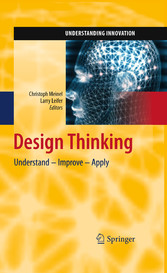Suchen und Finden
Service
Design Thinking - Understand - Improve - Apply
Hasso Plattner, Christoph Meinel, Larry Leifer
Verlag Springer-Verlag, 2010
ISBN 9783642137570 , 246 Seiten
Format PDF, OL
Kopierschutz Wasserzeichen
Geräte
'Everybody loves an innovation, an idea that sells.' But how do we arrive at such ideas that sell? And is it possible to learn how to become an innovator? Over the years Design Thinking - a program originally developed in the engineering department of Stanford University and offered by the two D-schools at the Hasso Plattner Institutes in Stanford and in Potsdam - has proved to be really successful in educating innovators. It blends an end-user focus with multidisciplinary collaboration and iterative improvement to produce innovative products, systems, and services. Design Thinking creates a vibrant interactive environment that promotes learning through rapid conceptual prototyping. In 2008, the HPI-Stanford Design Thinking Research Program was initiated, a venture that encourages multidisciplinary teams to investigate various phenomena of innovation in its technical, business, and human aspects. The researchers are guided by two general questions: 1. What are people really thinking and doing when they are engaged in creative design innovation? How can new frameworks, tools, systems, and methods augment, capture, and reuse successful practices? 2. What is the impact on technology, business, and human performance when design thinking is practiced? How do the tools, systems, and methods really work to get the innovation you want when you want it? How do they fail? In this book, the researchers take a system's view that begins with a demand for deep, evidence-based understanding of design thinking phenomena. They continue with an exploration of tools which can help improve the adaptive expertise needed for design thinking. The final part of the book concerns design thinking in information technology and its relevance for business process modeling and agile software development, i.e. real world creation and deployment of products, services, and enterprise systems.
Service
Shop










